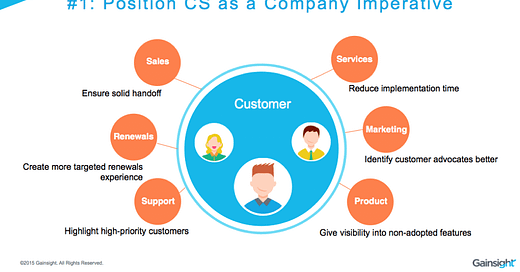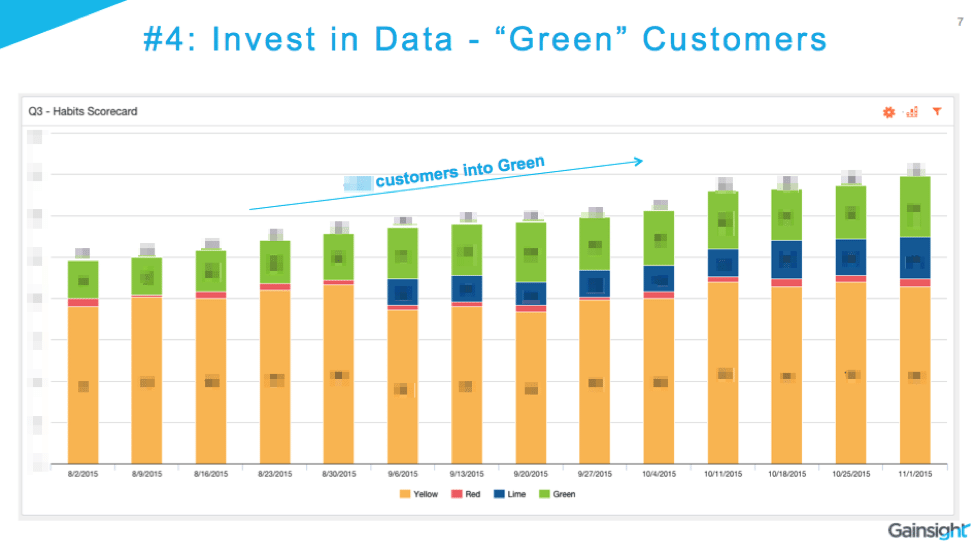Chances are, you’re working on your budget for 2016. And chances are, you’re waking up in the middle of the night, grappling with questions such as:
– How will I handle the incoming sales pipeline if I can’t grow my team?
– Will Sales or Marketing get preference in the budgeting process?
– What type of CSMs should I hire?
– How will we satisfy customers’ requests for a higher-touch (more expensive) CSM?
And the list goes on. Here are 10 tips for securing the budget that you need.
#1: Position Customer Success as a Company Imperative
Present your vision for Customer Success not just as a siloed department, but as a team that can help orient your entire company around the needs of your customers. Customer Success teams can’t personally satisfy every customer request, but they can work with other departments cross-functionally to do so. Here’s how other departments can contribute to customer success, with the help of your CSM team.
#2: Articulate the Benefit to Other Departments
Get other executives’ support for your proposed investments in Customer Success. Other teams can hugely benefit from CSMs’ work, as shown below and in my prior blog post on this topic.
#3: Pinpoint Your Metrics
Even while you’re championing Customer Success as a company priority, not just another department, you’ll need to communicate which metrics your CSM team should be accountable for. CSM teams come in all shapes and colors; the metrics they tend to be responsible for vary. Here are the metrics that our team at Gainsight focuses on. Note that our day-to-day activities drive operational metrics, which then lead to financial outcomes.
#4: Invest in Data
Start investing in aggregating data now, so that you can accumulate evidence that Customer Success is worth investing in. You’ll want to ask for the budget to purchase a customer success software solution that easily can track this data, in order to bolster your ability to get more budget for your team in the future.
One example of an operational metric that we track through Gainsight is Green Habits. “Habits” is our word for the degree to which the customer exhibits sticky adoption, which indicates that they’re deriving value from the product. The chart below (with sanitized data) shows the mix of customers across different levels of Habits, and how we’re moving customers from lower levels of adoption (red and yellow) into higher levels (green and blue).
#5: Budget to Benchmarks
If you still haven’t been able to track data on the value that your customer success team is adding, you’ll need to rely on industry benchmarks as a source of proof that there’s a positive ROI in investing in Customer Success.
Pacific Crest did a survey of SaaS companies that showed that the median expenditure on driving renewals was $0.13 for every $1.00 of ARR. I’ve rounded that to 15 cents in the diagram below, due to feedback on this metric that I’ve heard from investors. As you’re crafting your budget, you’ll want to make sure that your fully loaded cost of CSM is less than 15 cents per dollar of ARR.
Lots of CSM leaders debate how many accounts a CSM should manage. But there’s no magic answer to that question; the answer is “it depends.” Your only constraint for each segment of your CSM team is the 15-cent limit. You can achieve that limit using 3 drivers.
Reduce the cost of CSM, including by hiring more junior team members or hiring in less expensive locations.
Increase the number of accounts managed per CSM.
Increase the ARR of each account, by contributing to your company’s pricing strategy, driving more upsell, or charging for customer success, which many smart companies are doing.
If you’re finding that you’re constrained on one of these metrics — for example, you might hit a natural limit to the number of accounts a CSM can manage without harming the customer experience — then focus on changing the other metrics.
#6: Focus on What’s Scalable
Often when people talk about investing in Customer Success, they talk only about hiring people. In reality, Customer Success isn’t just a team of people — it’s a complex operation that involves giving feedback to the Product team on customers’ challenges, generating content, creating a community where customers can help each other, and other activities that are much more scalable than hiring more CSMs. When you’re budgeting, think about the operational activities you’re investing in.
The pyramid below shows, from bottom to top, the most scalable activities you can invest in — i.e. the activities that give you the most bang for your buck. Giving feedback to your product team is the most scalable thing you can do. CSMs often compensate for gaps in your product. If you can help your Product team fill those gaps, you can slow your hiring.
#7: Plan to Specialize
Even if you focus on activities that scale, you’ll probably still need to hire people as your company grows. Typically, early stage companies hire “unicorn CSMs” that are jack-of-all-trades. As you grow, you can make your team more effective and efficient (and make it easier to recruit people at scale) by dividing that unicorn role into specializations.
#8: Assign Value to High-Touch CS
As you segment your customers, you’ll likely realize that your initial CSM engagement model doesn’t work for the tail ends of your customer spectrum: the smallest customers and the largest ones.
Your largest customers typically will ask for a higher-touch experience. You may find that you’ll need to charge for those higher-value services — in a “Premier CSM” offering — in order to justify the incremental costs. If you’re in a new market, you may find that the demand for this offering is particularly strong.
#9: Develop a Repeatable Methodology
It’s not enough to hire stellar high-touch CSMs; you’ll still need to standardize their activities in order to scale effectively. Through our Success Plan process, we’ve created a methodology for Predictable Value Delivery — a repeatable set of steps for helping customers derive value from our product.
Our Success Plan process is described in more detail here. One of the critical steps is a standardized way of discovering the customer’s pain points. We’ve captured the ~25 most common business challenges that our customers have, in order to facilitate the kick-off conversation.
We then capture those business priorities in a Success Plan, which serves as a roadmap.
#10: Invest in Customer Success Operations
It will be challenging to achieve steps 1-9 on your own as an exec or team leader. Customer Success Operations makes this all possible. I’ve written more about the Customer Success Operations role here.
___
If you have questions about how to budget for your team, contact your Gainsight CSM. You can also reach out to Allison at apickens@gainsight.com or follow her weekly blog posts at @PickensAllison.













